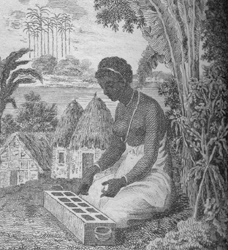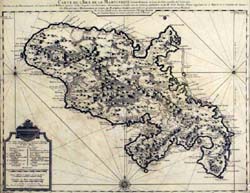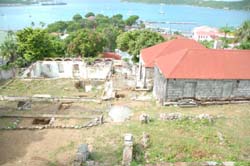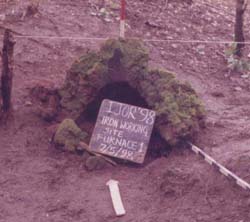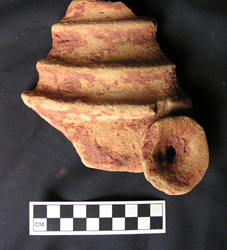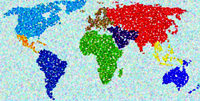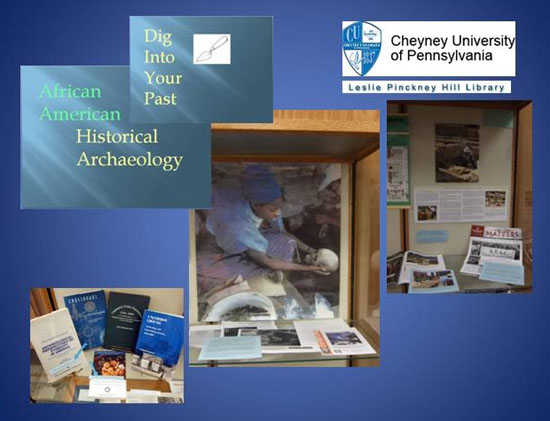  June 2009 NewsletterISSN: 1933-8651In this issue we present the following articles, news, announcements, and reviews: Uncovering Inspiration: Current Archaeology Investigations |
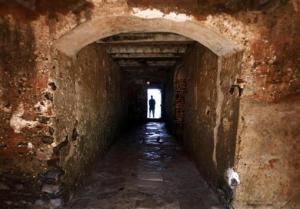 |
| A man is silhouetted in the "Door of No Return" at Goree Island in Senegal, where African slaves were shipped out. Photo by Finbarr O'Reilly, Reuters. |
However, the resolution is not without controversy. Some are upset by the last lines of the resolution that include a disclaimer: "Nothing in this resolution -- A) authorizes or supports any claim against the United States; or B) serves as a settlement of any claim against the United States."
Democratic Senator Roland Burris, the lone African-American in the Senate, argued that the disclaimer should not prohibit future congressional action on the issue of reparations. Despite the concern, the resolution passed the Senate by voice vote.
Iowa Senator Tom Harkin noted that the Senate adopted resolutions apologizing to Native Americans, for the internment of Japanese Americans during World War II and for not enacting anti-lynching legislation -- but never slavery.
"A national apology by the representative body of the people is a necessary collective response to a past collective injustice," Harkin said on the Senate floor.
[Return to table of contents]In Memoriam: Philip D. Curtin, 1922–2009
June 5, 2009
Published online by the American Historical Association, at
http://blog.historians.org/profession/809/in-memoriam-philip-d-curtin
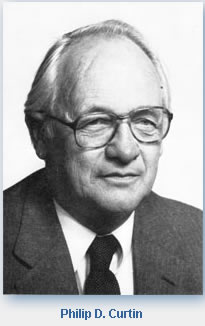
"This is no ordinary book," wrote Geoffrey Parker in the American Historical Review of December 1985, reviewing Cross-cultural Trade in World History, published by Cambridge University Press in 1984. This was no ordinary historian, one might write with equal justification, of the book's author, long-time member and president (in 1983) of the AHA, Philip D. Curtin, who died yesterday, June 4, 2009, in Kennett Square, Pennsylvania, at the age of 87.
Born in Philadelphia in 1922, Philip Curtin grew up in West Virginia. He received his early collegiate education at Swarthmore College, graduating with a degree in history in 1948, after three years of service in the Merchant Marine. He had already fallen in love with history and decided to make it a lifelong commitment, it seems, since he joined the AHA the same year, even before he went on to Harvard University for his PhD, which he received in 1953 for his dissertation, "Revolution and Decline in Jamaica, 1830–1865."
Curtin started his long teaching career as an assistant professor back at Swarthmore College. He then moved to the University of Wisconsin at Madison. Here he teamed up with colleague Jan Vansina to help launch and develop the hitherto neglected field of African history, and started a department of African languages and literature (the first such department in the United States). With a series of pathbreaking publications such as The Atlantic Slave Trade: A Census, which raised new questions even as it set new standards for accurate cliometrics of a complex past, The World and the West: The European Challenge and the Overseas Response in the Age of Empire, The Rise and Fall of the Plantation Complex: Essays in Atlantic History, and The Image of Africa: British Ideas and Action, 1780–1850 (which received the AHA's Schuyler Prize), Curtin made himself a name as a brilliant historian who broke away from the dominant Eurocentric models of historiography of other continents to create a critical and pioneering body of scholarship on Africa, the Atlantic world, the British empire, and comparative history. As if responding to the tug of the Atlantic (and perhaps a love of the sea rooted in his tenure with the Merchant Marines) reflected in his works, Curtin moved to the Johns Hopkins University in Baltimore in 1975, where he became the Herbert Baxter Adams Professor of History.
Curtin, it has been said, wore his scholarly distinctions -- the Guggenheim and MacArthur Fellowships, the fellowship of the National Academy of Arts and Sciences, among others -- and the sheer magnitude of his scholarship, lightly and unostentatiously. Yet he insisted that his numerous graduate students meet the same high standards that he set for himself.
"The discipline of history has broadened enormously in the postwar decades, but historians have not," Philip Curtin declared in his presidential address to the AHA, lamenting the increasingly narrow specializations of too many historians who thus remained ignorant of developments in fields outside their own. He himself was an exception, almost singlehandedly (but along with his many students, surely) defying the trend toward ever-narrowing subspecializations for more than 50 years. From intellectual history to the history of pandemics, from imperialism in India to the ecological history of the Chesapeake Bay, Curtin roamed across space, time, and specializations in a time-machine of his own invention.
It is telling that he begins his recently published autobiographical work, On the Fringes of History: A Memoir (Ohio University Press, 2005), "Being a West Virginian is a little different from being a Californian or a New Yorker," and then, unable to repress the cliometrician in him, adds, "Part of the difference is quantitative."
This report is based on material drawn from the Johns Hopkins University's Gazette Online of May 4, 1998, an unsigned biography of Philip Curtin distributed at the December 1983 annual meeting, and the AHA's membership records.[Return to table of contents]
Africa's Genetic Secrets Unlocked
Science Reporter, BBC News
May 1, 2009
Posted online May 1, 2009 by BBC News at
http://news.bbc.co.uk/2/hi/science/nature/8027269.stm
Copyright 2009, BBC News.
A genetic map of Africa -- the continent from which all modern humans originate -- has provided information about its huge diversity of language and culture.
It is the result of the largest African genetic study ever undertaken.
The work revealed the continent to be the most genetically diverse place on Earth, and identified descendents of our earliest human ancestors.
The international team of scientists describe their 10-year study in the journal Science.
The team, led by Sarah Tishkoff from the University of Pennsylvania, studied genetic material from 121 African populations.
They collected over 3,000 samples, and identified 14 "ancestral population clusters". These are groups of populations with common genetic ancestry, who share ethnicity and similarities in both their culture and the properties of their languages.
"This is a spectacular insight into the history of African populations and therefore the history of mankind," said Muntaser Ibrahim, a researcher from the University of Khartoum, who was also involved in the study.
The team looked at individual ancestry, or genetic similarities in their samples, by comparing the frequencies of more than 1,000 DNA markers -- sections of the DNA code that are known to reveal common genetic heritage.
"In the past, [geneticists] studied just a few Africans, and suggested they were representative of the continent, but we've found that no population is representative of all of this diversity," said Dr. Tishkoff.
"Our goal has been to do research that will benefit Africans," she said. "I hope this will set the stage for future genomics research there, and future biomedical research."
The completion of the study could enable such research, allowing the link between genes and disease to be properly studied.
"The genetic variants we've identified may play a role in disease susceptibility and the different ways in which people respond to drugs," Dr. Tishkoff explained.
Remote ResearchHer team had to gather genetic samples from some of the continent's most remote communities.
To extract the important information from blood samples, they have to be "spun down", using a centrifuge to produce a pellet containing the DNA.
"In the most remote areas, we used a centrifuge that plugged into a car battery," Dr. Tishkoff recalled.
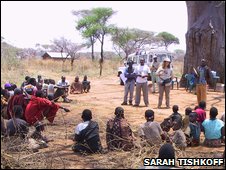 |
| A Village in Tanzania that participated in the study. Photo by Sarah Tishkoff, University of Pennsylvania. |
Largely as a result of these difficulties, a large amount of the group's data comes from populations that have never previously been studied genetically.
This allows the map to provide an entirely new link between biology, and existing anthropology and linguistic information.
The research also located the origin of modern human migration in south-western Africa, near the coastal border of Namibia and Angola.
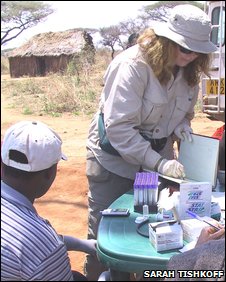 |
| To operate in remote areas, some equipment had to run on a car battery. Photo by Sarah Tishkoff, University of Pennsylvania. |
This is based on the widely-accepted theory that the highest level of genetic diversity is in the oldest population -- the one that has had the longest to evolve.
The site is the homeland of the indigenous San communities, Dr. Tishkoff explained.
"It's not surprising but it's a very neat finding because the San have already been shown to have the oldest genetic lineages, suggesting they may be descendents of a population ancestral to all modern humans."
Genetic ReconstructionThe data has revealed a great deal about the history of the continent. "This is the first time we have had the genetic data to reconstruct migration events," Dr. Tishkoff commented.
Her team, which represented an variety of academic disciplines, showed how genetic and linguistic diversity have co-evolved. This analysis revealed some surprises.
"The Masai people [in Kenya], for example, have maintained their traditional language and pastoral lifestyle, but genetically they've mixed a lot with populations from Ethiopia [who speak a different language]," said Dr. Tishkoff.
The researchers also took samples from four African American populations, and traced their African ancestry. This was, as expected, mostly pinned down to West Africa.
Mark Thomas from the Department of Genetics, Evolution and Environment at UCL praised the study, and said that the level of diversity discovered was "broadly what we would expect".
He added that because the origins of African American ancestry can be seen "all the way from Senegal down to Angola, it will be a long time before a DNA test will be able to identify someone's ancestral origin."
"That's despite the ridiculous claims of some of these DNA testing companies."
[Return to table of contents]NOAA and the National Association of
Black Scuba Divers Explore Shared History
May 20, 2009
Posted online May 20, 2009 by NOAA News, at: http://www.noaanews.noaa.gov/stories2009/20090521_blackdiver.html
Copyright 2009, NOAA News.
National Oceanic and Atmospheric Administration (NOAA) archaeologists will be in the Florida Keys this month training members of the National Association of Black Scuba Divers in underwater archaeology as part of a new education initiative to explore the maritime heritage of African-Americans and engage the community in marine resource conservation.
"By telling the many stories about African-Americans in seafaring, naval service, and the maritime trades, the project inspires a rediscovery of African-American maritime roots," said Tim Runyan, NOAA maritime heritage program manager.
Fifteen participants will be taught the science of maritime archaeology and learn basic underwater surveying, recording and mapping techniques during the May 22-24 training course. The course will include classroom and fieldwork exercises on a shipwreck in Florida Keys National Marine Sanctuary, and stress the importance of conservation and preservation of the nation’s underwater cultural heritage.
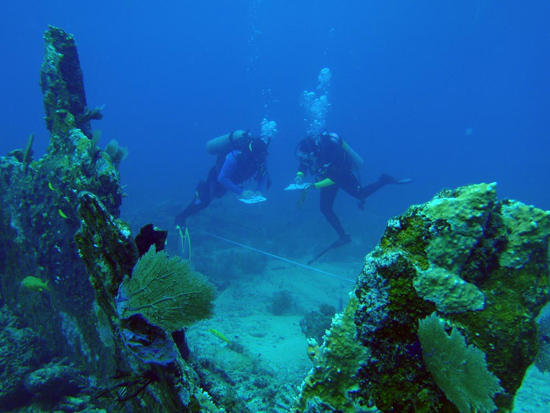 |
| Photo of divers by National Oceanic and Atmospheric Administration. |
NABS member Bill Murrain said the dive group’s commitment to education and public outreach aligns perfectly with the African-American "Voyage of Discovery" education and outreach initiative coordinated by the NOAA Office of National Marine Sanctuaries.
"African-Americans have made significant contributions to the country’s maritime history and the archaeological training course will give NABS an opportunity to help bring this history to a wider public," Murrain said.
The training is also part of a larger NOAA effort to create a cadre of skilled volunteers who can assist with archaeological field work and historic research occurring within the National Marine Sanctuary System.
NOAA's Maritime Heritage Program and the Nautical Archaeology Society developed the training course to introduce divers to the field of maritime archaeology. Since the training program began, about 20 people have been trained as volunteer divers, seven of whom have become members of the national marine sanctuary volunteer diving program.
NOAA understands and predicts changes in the Earth’s environment, from the depths of the ocean to the surface of the sun, and conserves and manages our coastal and marine resources.
[Return to table of contents]Tracing the Threads that Join America and Africa
New York Times
May 3, 2009
Posted online May 3, 2009 by New York Times, at: http://www.nytimes.com/2009/05/04/arts/design/04muse.html?_r=2&ref=todayspaper
Copyright 2009, New York Times.
I'll admit my expectations are pretty low when it comes to new architecture in the nation's capital.
True, Norman Foster completed a pretty little canopy for the National Portrait Gallery's central courtyard in 2007. But over all the crop of monuments and museums that have risen along the National Mall in recent decades have been so mediocre that it seems to be only a matter of time before this sacred strip of land becomes a national embarrassment.
So the first reaction to the announcement that the team of Freelon Adjaye Bond/SmithGroup has been selected to design the National Museum of African American History and Culture should be a big round of applause. David Adjaye, the project's 42-year-old lead designer, is a rising star in the architecture world.
The design's strong, somber exterior -- a stack of zigzagging blocks clad in shimmering bronze mesh -- could be the most important addition to the mall since I. M. Pei's East Building at the National Gallery of Art opened three decades ago.
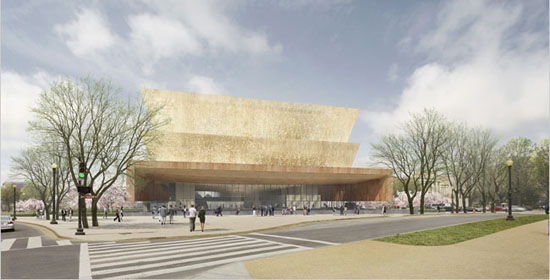 |
| A rendering of the National Museum of African American History and Culture now being planned for Washington, by the Freelon Adjaye Bond/SmithGroup. |
It is also a history lesson. Mr. Adjaye, who was born in Tanzania and lives in London, says that the museum's form is based on late 19th- and early 20th-century tribal Yoruban sculpture.
The sculptural reference is an obvious attempt to express the frayed cultural threads that link black America and West Africa. Yet it also carries subtler cultural associations: the stacked wood blocks, which evoke an African version of the Parthenon caryatids, remind us that Washington's neo-Classical buildings represent only part of a vastly more intricate cultural narrative. The new design's ziggurat-shaped form evokes the work of Constantin Brancusi, one of many Western artists who were profoundly influenced by African tribal art.
This effort to broaden the narrative of Classical Washington -- and to challenge how many Americans still view their history -- continues inside. Two huge stone canopies extend out from the building to the north and south, fudging the boundary between the formal world of the museum and everyday life outside. The lobby floor, which slopes down from the Mall toward Constitution Avenue, is a reversal of the conventional grand stair. Instead of lifting art up onto a pedestal, it allows the public to flow right through the building.
For museumgoers, however, the design's greatest strength lies in the delicate balance struck between the need to move crowds and the stillness that is so vital to the experience of viewing displays. A dense forest of wood columns is suspended from the lobby ceiling. The columns dip down at the center of the lobby, gently pushing the crowds toward the edges of the room. From there, visitors will climb a broad staircase to the main galleries, which are on the second, third and fourth floors.
In a cheeky inversion of Frank Lloyd Wright's famous Guggenheim rotunda, Mr. Adjaye clusters all of the galleries at the center of these floors. To get to them, visitors will follow a series of stairs, corridors and walkways that will spiral up around the building's perimeter.
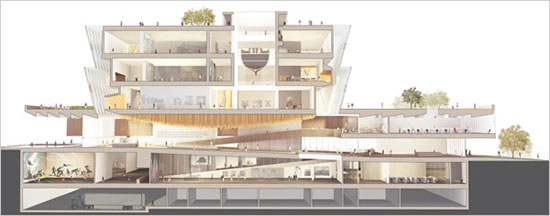 |
| A model of the National Museum of African American History and Culture on the National Mall, by the Freelon Adjaye Bond/SmithGroup. |
The layout allows Mr. Adjaye to isolate the main circulation route from the galleries, which should give them a wonderful calm. But it also lets him forge a strong relationship between the inner world of the museum and the city outside.
Big windows -- reminiscent of the trapezoidal ones at the Whitney Museum of American Art -- will angle out toward carefully framed views of the city's monuments. Rather than puncture the building's bronze mesh skin, Mr. Adjaye gently stretches it to allow people to see through it. At other points the pattern is denser, so that the light filtering in will have a mottled, bronze glow, as if it were streaming through a canopy of trees.
(The changes in the density of the bronze mesh should have a powerful effect on the building's exterior at night, too, giving it an eerie, uneven pattern, like a lizard's skin, when it is lighted from within.)
Still, expect plenty of nail-biting moments in the months and years to come. The design is still in the earliest stages, and the high degree of refinement in Mr. Adjaye's work means that its success will depend on the kind of details that have yet to be fully worked out. These include the precise layout of the galleries and the position of a number vertical cuts through the building that will be used to bring light into the lower levels.
What's more, Mr. Adjaye has never designed a cultural building of this scale. Nor has he ever worked with a bureaucratic culture as byzantine as Washington's. Finally, he will have to find a way to work with a sprawling team of associate architects without diluting the power of his original vision.
It will now be up to the museum's director, Lonnie G. Bunch, to ensure that he will have the kind of creative freedom necessary to thrive in this former swampland.
| ADAN Editor's note: Additional information, images, and updates on this design and construction project are available from the National Museum of African American History and Culture's website, at nmaahc.si.edu. |
[Return to table of contents]
New Book
By Merrick Posnansky
Radcliffe Press, Cloth, 288 pp.,
ISBN-10: 1845119940, ISBN-13: 978-1845119942, June 2009.
Description from the Publisher:
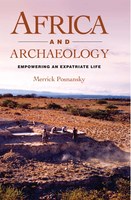 In this stimulating account of his life's experiences, renowned scholar and pioneer Africanist archaeologist Merrick Posnansky takes his readers on an unusual journey across the world, from his origins in a small Jewish community in Manchester to his adventures on archaeological sites in the villages of Africa before finally settling down to teach in Los Angeles. A Jewish British expatriate in an African social world, Posnansky struggled to establish his racial identity in the British colonial world where Jewish communities were rare. He crossed racial and religious boundaries by marrying a Christian woman from Uganda, a highly unusual step at that time. Written in a refreshing, candid style, these memoirs provide a fascinating glimpse into the changes taking place in modern Africa. Africa and Archaeology is a first hand account of the racial and religious prejudices of the twentieth century.
In this stimulating account of his life's experiences, renowned scholar and pioneer Africanist archaeologist Merrick Posnansky takes his readers on an unusual journey across the world, from his origins in a small Jewish community in Manchester to his adventures on archaeological sites in the villages of Africa before finally settling down to teach in Los Angeles. A Jewish British expatriate in an African social world, Posnansky struggled to establish his racial identity in the British colonial world where Jewish communities were rare. He crossed racial and religious boundaries by marrying a Christian woman from Uganda, a highly unusual step at that time. Written in a refreshing, candid style, these memoirs provide a fascinating glimpse into the changes taking place in modern Africa. Africa and Archaeology is a first hand account of the racial and religious prejudices of the twentieth century.Africa and Archaeology provides a personal memoir by an archaeologist who began his career in England in the 1950s, where he excavated (among other sites) a medieval tile kiln and a windmill in Northamptonshire that was was one of the first sites in Britain to be largely dated using tobacco pipes. From 1956 until 1976 Posnansky worked in Kenya, Uganda, and Ghana, where he was responsible for initiating the first university courses in tropical Africa in archaeology, first at Makerere College in Uganda, and later at the University of Ghana. He was one of the first archaeologists in the 1950s to use the term Historical Archaeology in Africa.
From 1977 until his retirement in 1994, Posnansky was Professor of History and Anthropology at the University of california at Los Angeles (UCLA), where he taught classes in both Historical and African Archaeology. His memoirs describe both his teaching and research career and work in East and West Africa as well as in the Caribbean. His students who have carried on his work include such Diasporan archaeologists as Douglas Armstrong, Kenneth Kelly, Christopher DeCorse, Kofi Agorsah, Laurie Wilkie, Paul Farnsworth, and Cameron Monroe.
This new book provides a fascinating account of the beginnings of Diasporan archaeology, and also describes Posnansky's life in Africa and marriage to Eunice Lubega, who was the first African woman to graduate in East Africa. Since retirement, he has returned to research in Uganda where in 2006-07, with the assistance of students from two of Uganda's universities, he excavated the late 19th century Egyptian military station of Dufile on the Nile near the Sudanese border. Posnansky's most recent paper, appearing in the 2009 issue of Backdirt (published by UCLA), is entitled "Reconciling the Past" and deals with the ethical problems of conserving Imperial sites in Africa.
[Return to table of contents]
New Book
Edited by Toyin Falola and Aribidesi Usman
Rochester Studies in African History and the Diaspora
University of Rochester Press, Cloth, 332 pp.,
ISBN-10: 1580462960, ISBN-13: 978-1580462969, May 2009.
Description from the Publisher:
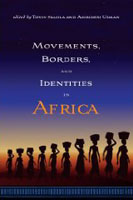 Migration, whether forced or voluntary, continues to be an issue vital to Africa, arguably the continent most affected by internal displacement. Over centuries, in groups or as individuals, Africans have been forced to leave their homes to escape unfavorable natural, social, or political circumstances, or simply to seek better lives elsewhere. This essential volume establishes the centrality of human migration and movement to the evolution of African societies. Using oral, archaeological, and written sources, and focusing on various geographical areas, the contributors show that migration is a multifaceted phenomenon, historically varied in nature and character. Movements, Borders, and Identities in Africa incorporates carefully selected case studies drawn from across the continent, and provides a broad but insightful overview of migration and its complex relationships to slavery, commerce, religion, architecture, material culture, poverty, diaspora life and identity formation, and the development of states and societies on the continent. Taken as a whole, this collection offers a groundbreaking interrogation of the myriad causes and effects of African migration, from the pre-colonial to the modern era. Contributors: Edmund Abaka, Maurice Amutabi, Toyin Falola, Ghislaine Geloin, Issiaka Mande, Jean-Luc Martineau, Pius S. Nyambara, Akinwumi Ogundiran, Adisa Ogunfolakan, Olatunji Ojo, Brigitte Kowalski Oshineye, Meshack Owino, Gerald Steyn, and Aribidesi Usman. Toyin Falola is the Frances Higginbotham Nalle Centennial Professor of History and Distinuished Teaching at the University of Texas at Austin. Aribidesi Usman is associate professor of African and African American studies and anthropology at Arizona State University.
Migration, whether forced or voluntary, continues to be an issue vital to Africa, arguably the continent most affected by internal displacement. Over centuries, in groups or as individuals, Africans have been forced to leave their homes to escape unfavorable natural, social, or political circumstances, or simply to seek better lives elsewhere. This essential volume establishes the centrality of human migration and movement to the evolution of African societies. Using oral, archaeological, and written sources, and focusing on various geographical areas, the contributors show that migration is a multifaceted phenomenon, historically varied in nature and character. Movements, Borders, and Identities in Africa incorporates carefully selected case studies drawn from across the continent, and provides a broad but insightful overview of migration and its complex relationships to slavery, commerce, religion, architecture, material culture, poverty, diaspora life and identity formation, and the development of states and societies on the continent. Taken as a whole, this collection offers a groundbreaking interrogation of the myriad causes and effects of African migration, from the pre-colonial to the modern era. Contributors: Edmund Abaka, Maurice Amutabi, Toyin Falola, Ghislaine Geloin, Issiaka Mande, Jean-Luc Martineau, Pius S. Nyambara, Akinwumi Ogundiran, Adisa Ogunfolakan, Olatunji Ojo, Brigitte Kowalski Oshineye, Meshack Owino, Gerald Steyn, and Aribidesi Usman. Toyin Falola is the Frances Higginbotham Nalle Centennial Professor of History and Distinuished Teaching at the University of Texas at Austin. Aribidesi Usman is associate professor of African and African American studies and anthropology at Arizona State University.[Return to table of contents]
New Book
Edited by Andrew B. Fisher and Matthew D. O'Hara
Duke University Press, Paperback, 320 pp.,
ISBN13 978-0-8223-4420-9, 2009.
Description from the Publisher:
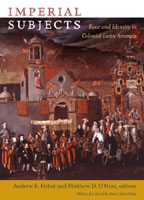 In colonial Latin America, social identity did not correlate neatly with fixed categories of race and ethnicity. As Imperial Subjects demonstrates, from the early years of Spanish and Portuguese rule, understandings of race and ethnicity were fluid. In this collection, historians offer nuanced interpretations of identity as they investigate how Iberian settlers, African slaves, Native Americans, and their multi-ethnic progeny understood who they were as individuals, as members of various communities, and as imperial subjects. The contributors' explorations of the relationship between colonial ideologies of difference and the identities historical actors presented span the entire colonial period and beyond: from early contact to the legacy of colonial identities in the new republics of the nineteenth century. The volume includes essays on the major colonial centers of Mexico, Peru, and Brazil, as well as the Caribbean basin and the imperial borderlands.
In colonial Latin America, social identity did not correlate neatly with fixed categories of race and ethnicity. As Imperial Subjects demonstrates, from the early years of Spanish and Portuguese rule, understandings of race and ethnicity were fluid. In this collection, historians offer nuanced interpretations of identity as they investigate how Iberian settlers, African slaves, Native Americans, and their multi-ethnic progeny understood who they were as individuals, as members of various communities, and as imperial subjects. The contributors' explorations of the relationship between colonial ideologies of difference and the identities historical actors presented span the entire colonial period and beyond: from early contact to the legacy of colonial identities in the new republics of the nineteenth century. The volume includes essays on the major colonial centers of Mexico, Peru, and Brazil, as well as the Caribbean basin and the imperial borderlands.Whether analyzing cases in which the Inquisition found that the individuals before it were "legally" Indians and thus exempt from prosecution, or considering late-eighteenth- and early-nineteenth-century petitions for declarations of whiteness that entitled the mixed-race recipients to the legal and social benefits enjoyed by whites, the book’s contributors approach the question of identity by examining interactions between imperial subjects and colonial institutions. Colonial mandates, rulings, and legislation worked in conjunction with the exercise and negotiation of power between individual officials and an array of social actors engaged in countless brief interactions. Identities emerged out of the interplay between internalized understandings of self and group association and externalized social norms and categories. Contributors: Karen D. Caplan, R. Douglas Cope, Mariana L. R. Dantas, María Elena Díaz, Andrew B. Fisher, Jane Mangan, Jeremy Ravi Mumford, Matthew D. O'Hara, Cynthia Radding, Sergio Serulnikov, Irene Silverblatt, David Tavárez, Ann Twinam.
[Return to table of contents]
New Book
By Edited by Catherine M. Lewis and J. Richard Lewis
University of Arkansas Press, Paperback, 280 pp.,
ISBN 978-1-55728-895-0, 2009.
Description from the Publisher:
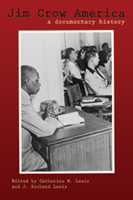 Ideal resource on racism and segregation in American life -- The term "Jim Crow" has had multiple meanings and a dark and complex past. It was first used in the early nineteenth century. After the Civil War it referred to the legal, customary, and often extralegal system that segregated and isolated African Americans from mainstream American life. In response to the increasing loss of their rights of citizenship and the rising tide of violence, the National Association for the Advancement of Colored People was founded in 1909. The federal government eventually took an active role in dismantling Jim Crow toward the end of the Depression. But it wasn't until the Lyndon Johnson years and all the work that led up to them that the end of Jim Crow finally came to pass.
Ideal resource on racism and segregation in American life -- The term "Jim Crow" has had multiple meanings and a dark and complex past. It was first used in the early nineteenth century. After the Civil War it referred to the legal, customary, and often extralegal system that segregated and isolated African Americans from mainstream American life. In response to the increasing loss of their rights of citizenship and the rising tide of violence, the National Association for the Advancement of Colored People was founded in 1909. The federal government eventually took an active role in dismantling Jim Crow toward the end of the Depression. But it wasn't until the Lyndon Johnson years and all the work that led up to them that the end of Jim Crow finally came to pass.This unique book provides readers with a wealth of primary source materials from 1828 to 1980 that reveal how the Jim Crow era affects how historians practice their craft. The book is chronologically organized into five sections, each of which focuses on a different historical period in the story of Jim Crow: inventing, building, living, resisting, and dismantling. Many of the fifty-six documents and eighteen images and cartoons, many of which have not been published before, reveal something significant about this subject or offer an unconventional or unexpected perspective on this era. Some of the historical figures whose words are included are Abraham Lincoln, Marcus Garvey, Booker T. Washington, Richard Wright, Paul Robeson, Langston Hughes, Adam Clayton Powell, and Marian Anderson. The book also has an annotated bibliography, a list of key players, a timeline, and key topics for consideration.
[Return to table of contents]
New Book
By Patrick Manning
Columbia Studies in International and Global History
Columbia University Press, Cloth, 424 pp.,
ISBN-10: 0231144709, ISBN-13: 978-0231144704, April 2009.
Description from the Publisher:
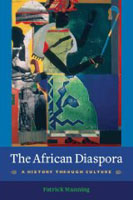 Patrick Manning refuses to divide the African diaspora into the experiences of separate regions and nations. Instead, he follows the multiple routes that brought Africans and people of African descent into contact with one another and with Europe, Asia, and the Americas. In weaving these stories together, Manning shows how the waters of the Atlantic Ocean, the Mediterranean Sea, and the Indian Ocean fueled dynamic interactions among black communities and cultures and how these patterns resembled those of a number of connected diasporas concurrently taking shaping across the globe.
Patrick Manning refuses to divide the African diaspora into the experiences of separate regions and nations. Instead, he follows the multiple routes that brought Africans and people of African descent into contact with one another and with Europe, Asia, and the Americas. In weaving these stories together, Manning shows how the waters of the Atlantic Ocean, the Mediterranean Sea, and the Indian Ocean fueled dynamic interactions among black communities and cultures and how these patterns resembled those of a number of connected diasporas concurrently taking shaping across the globe.Manning begins in 1400 and traces five central themes: the connections that enabled Africans to mutually identify and hold together as a global community; discourses on race; changes in economic circumstance; the character of family life; and the evolution of popular culture. His approach reveals links among seemingly disparate worlds. In the mid-nineteenth century, for example, slavery came under attack in North America, South America, southern Africa, West Africa, the Ottoman Empire, and India, with former slaves rising to positions of political prominence. Yet at the beginning of the twentieth century, the near-elimination of slavery brought new forms of discrimination that removed almost all blacks from government for half a century.
Manning underscores the profound influence that the African diaspora had on world history, demonstrating the inextricable link between black migration and the rise of modernity, especially in regards to the processes of industrialization and urbanization. A remarkably inclusive and far-reaching work, The African Diaspora proves that the advent of modernity cannot be imaginatively or comprehensively engaged without taking the African peoples and the African continent as a whole into account.
[Return to table of contents]
New Book
By John W. Ravage
University of Utah Press, Paperback, 336 pp.,
ISBN-13: 978-0-87480-941-1, 2d. ed. 2009.
Description from the Publisher:
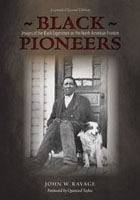 Few records exist that describe the migrations of African Americans in the nineteenth-century American West. Efforts to assemble collections of oral histories, images, diaries, and other written documents on the black experience in the Western U.S. and Canada have proven surprisingly fruitful, however, and the rewarding culmination of such research flourishes in the archival images found in this expanded second edition of John Ravage's Black Pioneers.
Few records exist that describe the migrations of African Americans in the nineteenth-century American West. Efforts to assemble collections of oral histories, images, diaries, and other written documents on the black experience in the Western U.S. and Canada have proven surprisingly fruitful, however, and the rewarding culmination of such research flourishes in the archival images found in this expanded second edition of John Ravage's Black Pioneers.Utilizing public and private collections in every western state and in Canada, Ravage has compiled hundreds of new photographs, line drawings, lithographs, stereoviews, and other images. Sections on black entertainers and ranchers, a chapter on dating historic photographs and their genealogical significance, as well as an expanded bibliography all aid understanding of the black frontier experience. Ravage goes beyond the stereotypical photography of the era, which often reflected white fears and egos, to present the works of black frontier photographers. Galveston's Lucius Harper, Denver's John Green, and the northwest's nomadic James Presley Ball all bring genuine life to their subjects and meaning to their presence in the American West. Black Pioneers is a vibrant visual document of the profound impact blacks on communal and frontier history. John W. Ravage is professor emeritus of mass media at the University of Wyoming.
[Return to table of contents]
New Book
Edited by Marjorie J. Spruill, Valinda Littlefield, and Joan M. Johnson
University of georgia Press, Paperback, 320 pp.,
ISBN 0820329363, 2009.
Description from the Publisher:
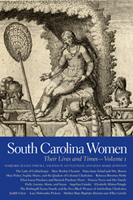 The first of three volumes on South Carolina women. This volume, which spans the long period from the sixteenth century through the Civil War era, is remarkable for the religious, racial, ethnic, and class diversity of the women it features. Essays on plantation mistresses, overseers' wives, nonslaveholding women from the upcountry, slave women, and free black women in antebellum Charleston are certain to challenge notions about the slave South and about the significance of women to the state's economy. South Carolina's unusual history of religious tolerance is explored through the experiences of women of various faiths, and accounts of women from Europe, the West Indies, and other colonies reflect the diverse origins of the state's immigrants.
The first of three volumes on South Carolina women. This volume, which spans the long period from the sixteenth century through the Civil War era, is remarkable for the religious, racial, ethnic, and class diversity of the women it features. Essays on plantation mistresses, overseers' wives, nonslaveholding women from the upcountry, slave women, and free black women in antebellum Charleston are certain to challenge notions about the slave South and about the significance of women to the state's economy. South Carolina's unusual history of religious tolerance is explored through the experiences of women of various faiths, and accounts of women from Europe, the West Indies, and other colonies reflect the diverse origins of the state's immigrants.The volume begins with a profile of the Lady of Cofitachequi, who sat at the head of an Indian chiefdom and led her people in encounters with Spanish explorers. The essays that follow look at well-known women such as Eliza Lucas Pinckney, who managed several indigo plantations; the abolitionist Angelina Grimke; and Civil War diarist Mary Boykin Chesnut. Also included, however, are essays on the much-less-documented lives of poor white farming women (the Neves family of Mush Creek), free African American women (Margaret Bettingall and her daughters), and slave women, the latter based on interviews and their own letters. The essays in volume 1 demonstrate that many women in this most conservative of states, with its strong emphasis on traditional gender roles, carved out far richer public lives than historians have often attributed to antebellum southern women.
[Return to table of contents]
New Book
By Charles F. Irons
University of North Carolina Press, Paperback, 384 pp.,
ISBN-10: 0807858773, ISBN-13: 978-0807858776, 2008.
Description from the Publisher:
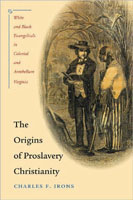 In the colonial and antebellum South, black and white evangelicals frequently prayed, sang, and worshipped together. Even though white evangelicals claimed spiritual fellowship with those of African descent, they nonetheless emerged as the most effective defenders of race-based slavery.
In the colonial and antebellum South, black and white evangelicals frequently prayed, sang, and worshipped together. Even though white evangelicals claimed spiritual fellowship with those of African descent, they nonetheless emerged as the most effective defenders of race-based slavery.As Charles Irons persuasively argues, white evangelicals' ideas about slavery grew directly out of their interactions with black evangelicals. Set in Virginia, the largest slaveholding state and the hearth of the southern evangelical movement, this book draws from church records, denominational newspapers, slave narratives, and private letters and diaries to illuminate the dynamic relationship between whites and blacks within the evangelical fold. Irons reveals that when whites theorized about their moral responsibilities toward slaves, they thought first of their relationships with bondmen in their own churches. Thus, African American evangelicals inadvertently shaped the nature of the proslavery argument. When they chose which churches to join, used the procedures set up for church discipline, rejected colonization, or built quasi-independent congregations, for example, black churchgoers spurred their white coreligionists to further develop the religious defense of slavery.
[Return to table of contents]
New Exhibit
June 16, 2009 onward
African American Museum in Philadelphia
701 Arch Street, Philadelphia, PA.
Description from the Museum:
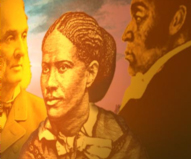 On June 19, 2009, The African American Museum in Philadelphia (AAMP) unveiled its new core exhibition Audacious Freedom: African Americans in Philadelphia 1776-1876, presented by PECO. Its primary focus is to re-count the stories of and contributions made by people of African descent in Philadelphia. The overall goal is to draw visitors into another time and place called "history," where they can encounter and come to understand the people who created the world that they now inhabit. Through this exhibit visitors will learn who the people were, how they lived and worked, and their unheralded impact on our nation.
On June 19, 2009, The African American Museum in Philadelphia (AAMP) unveiled its new core exhibition Audacious Freedom: African Americans in Philadelphia 1776-1876, presented by PECO. Its primary focus is to re-count the stories of and contributions made by people of African descent in Philadelphia. The overall goal is to draw visitors into another time and place called "history," where they can encounter and come to understand the people who created the world that they now inhabit. Through this exhibit visitors will learn who the people were, how they lived and worked, and their unheralded impact on our nation.When entering the Museum, visitors will be welcomed with a general overview of the exhibition in Gallery 1, including an interactive timeline, highlighting a sequence of images, all drawn from the historical record, that spans 100 years of history. The images found on the timeline will illuminate and explore topics of relevance including entrepreneurship, environment, education, religion, and family traditions. In Gallery 2, visitors will be surrounded by what appear to be ten full-size figures of trailblazers from 18th Century Philadelphia. The figures are actually full-size video projections, patiently waiting for a visitor to approach and actively engage them. Once activated, the individual trailblazer delivers an impassioned monologue about life in Philadelphia during the time period. Adjacent to each full-size screen will be a small touch-screen complete with a menu of topics that this particular trailblazer will discuss upon activation. Sound is delivered by directional speakers utilizing cutting-edge technology that will filter the sound. These speakers create an atmosphere similar to a genteel cocktail party, with each dialogue clearly understandable and undisturbed by additional visitors exploring the stories of other agents of change.
[Return to table of contents]
New Exhibit
April 24, 2009 - January 3, 2010
Royal Museum for Central Africa
Leuvensesteenweg 13, 3080 Tervuren, Belgium.
Description from the Museum:
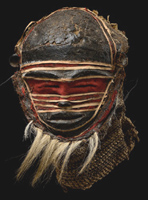 By examining the use of masks in dances, rituals and the belief system they serve and represent, the book also explores their concrete and symbolic roles as objects that are "devitalized" once they have been removed from their environment. They raise questions about identity, self-respect and the perception of the "Other" in Western society. A mask hides an identity, or reveals it. The traditional mask, used during African ceremonies and festivals, is always more than the wooden face worn by the dancer: it allows an entity to take shape, with its own way of dancing and moving. The wearer transforms into another person, a deity, sometimes even an animal. The exhibition presents 180 masks in an original way, grouped according to 18 themes including the history of the collection and the role of the mask in communication with the supernatural, in the harvest, during initiation rituals, at funerals, etc.
By examining the use of masks in dances, rituals and the belief system they serve and represent, the book also explores their concrete and symbolic roles as objects that are "devitalized" once they have been removed from their environment. They raise questions about identity, self-respect and the perception of the "Other" in Western society. A mask hides an identity, or reveals it. The traditional mask, used during African ceremonies and festivals, is always more than the wooden face worn by the dancer: it allows an entity to take shape, with its own way of dancing and moving. The wearer transforms into another person, a deity, sometimes even an animal. The exhibition presents 180 masks in an original way, grouped according to 18 themes including the history of the collection and the role of the mask in communication with the supernatural, in the harvest, during initiation rituals, at funerals, etc.Catalogue of the exhibition co-published by the Royal Museum for Central Africa and 5 Continents, in English, French and Dutch. Written by Anne-Marie Bouttiaux, the exhibition's organizer, this work also includes an essay by Roger Pierre Turine. ISBN 978-88-7439-513-2. Additional information is available at www.africamuseum.be.
[Return to table of contents]
Association for the Study
of the Worldwide African Diaspora
Fifth Biennial Conference
Accra, Ghana, August 2-6, 2009
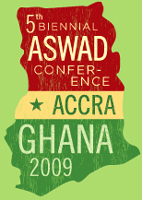
You are invited to participate in the fifth biennial conference of the Association for the Study of the Worldwide African Diaspora (ASWAD), to be held August 2-6, 2009, in Accra, Ghana. The conference is co-sponsored by Rutgers University and the W.E.B. Du Bois Center in Accra, with the support of Ghana's Ministry of Tourism and Diasporan Relations. In commemoration of both the Pan-African Conference of 1900 and the Pan-African Congress of 1919, and in celebration of Ghana's central role in nurturing Pan-African struggles for freedom and justice since 1957, the theme of the conference is "Africa, Diaspora, and Pan-African Agendas."
The conference will be research driven, featuring panels organized in ways that effectively stimulate discourse across geographic, disciplinary, cultural, and theoretical boundaries. Emphasis will also be given to the practice and performance of culture, identity, and politics. Participants were encouraged to propose roundtable discussions and participatory workshops that look at diasporic encounters in all activities from educational policies to cooking practices. All geographic areas will be represented, including Africa, the Americas, the Middle East, Europe, and Asia. Paper and panel proposals that incorporate women, gender, and sexuality as categories of analysis were also encouraged. Conference registration, travel, and accommodation information and links available at: http://www.aswadiaspora.org/ghana09.html
[Return to table of contents]Twelfth Biennial Colloquium of the
West African Archaeological Association
Jos, Nigeria, October 25-30, 2009
It is our pleasure to notify you that the 12th Biennial colloquium of our great Association will come up this year in Nigeria. The meeting is slated for October 25th to 30th, 2009 in Jos, Nigeria.
It has been observed that most of the works done in West Africa always end up in files and without sharing of ideas and experiences by West African archaeologists in particular and scholars of history and culture in general. It is therefore the hope of the Local Organising Committee (LOC) that bringing professionals and academics working in West Africa sub-region together to share their works and experiences will be ideal at this particular point in time. It is therefore suggested that a broad theme on the archaeology of West Africa will be appropriate.
The proposed theme, therefore, for this year’s deliberation is "The Archaeology of West Africa," with the following sub-themes: 1) Environment -- past and present; 2) Geography of West Africa and its effect on human habitation; 3) Archeology of West Africa: research reports; 4) Heritage and sites: conservation and preservation; 5) Ethics of archaeological practice in West Africa.
You are therefore requested to send your abstract not more than 500 words on the theme or sub-themes to the Secretary or Chairperson of the LOC on bogunfol@oauife.edu.ng or babaadii@yahoo.com and fatunsina@yahoo.com. Other details will be sent to you soon. Adisa Ogunfolakan, Secretary, Room 216, Institute of African Studies, Obafemi Awolowo University, Ile-Ife, Nigeria. LOC. 234-803-717-6488 or 234-807-641-0094.
[Return to table of contents]
Negotiating the Sacred: Politics, Practice,
and Perceptions of Religion in Africa
Stanford University, October 23-24, 2009
From piety in Egypt to AIDs/HIV programming in South Africa, religion provides not only a vibrant subject of study in and of itself but also a lens to refract social, economic, and political relations. The Student Forum for African Studies conference in October 2009 at Stanford University, will bring together researchers from across many fields to discuss emerging approaches, local practice, and transnational movements of religion in Africa and the Diaspora. Possible topics could include: public policy and administration, public health, demography and mobility, art history, youth culture and music, film and performance art, law, literature, history, politics, or anthropology.
Abstracts or descriptions of the presentations, posters, or papers should be no longer than 250 words and should include contact information, name, mailing address, telephone number, affiliation, department and email address. Eligibility: Although we strongly encourage graduate students, we also welcome submissions from undergraduates, professionals, post-doctoral researchers, lecturers, professors, activists, and practitioners. Papers and presentations on topics related to Africa in all disciplines and from all institutions, programs, and organizations will be considered. Deadine: August 1, 2009. Abstracts or descriptions may be sent via email to stanfordfas@gmail.com.
[Return to table of contents]Gender, Class, Race, and Ethnicity in Abolitionism,
on the Underground Railroad, and in the Struggle Since
New York Capital Region, February 26-28, 2010
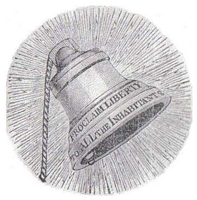
This Ninth Annual Underground Railroad History Conference is sponsored by the Underground Railroad History Project of the Capital Region, Inc. The forces of gender, class, race, and ethnicity have deeply and complexly conditioned the Underground Railroad and the movements for freedom that have arisen in its wake. The theme of the 2010 UGR History Conference calls on us as academic scholars, independent researchers, performers, educators, and community members to examine the many ways that these forces interacted to shape the UGR and the struggles that followed it, and to consider how these interactions impact us today.
Possible questions to be considered: In what ways did gender, class, race, and ethnicity -- individually or in combination -- determine the programs, leaderships, activities, ideologies, and crises of UGR and abolitionist groups, locally and/or nationally? How did abolitionists and UGR participants understand, react to, and negotiate the contradictions of gender, class, race, and ethnicity in antebellum US society? What were the legacies of the UGR’s attempts to grapple with gender, class, race, and ethnicity for post-Civil war struggles for freedom and equality? How can we best learn from the successes and failures of the UGR and abolitionist movement in dealing with these forces in our work today?
Your proposal may be for a 60-minute panel session, workshop, cultural/artistic activity, media production, poster, or other exhibit that addresses these questions and this theme. While we urge that the content focuses on the theme, we also invite proposals on other important topics concerning Underground Railroad history. When possible, activities should encourage audience interaction. Proposals should be no more than two doublespaced pages, and should include information on the following: type of presentation (workshop, panel, etc.) and level of audience interaction; title and content, including topics of individual presentations, if any; intended, appropriate audience; name(s), contact information (including work, home, cell phone), and brief biographical information on presenter(s); technology needs. Proposals should be submitted by October 1, 2009, to URHPCR, PO Box 10851, Albany, NY 12201, or via email to urhpcr2010@localnet.com. For more information, see www.ugrworkshop.com or call 518-432-4432.
[Return to table of contents]Women in the Ibero-American Atlantic (1500-1800)
Charleston, South Carolina, Feb. 18-20, 2010
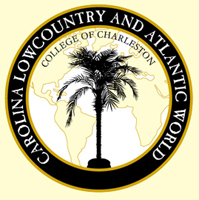
The Program in the Carolina Lowcountry and Atlantic World (CLAW) at the College of Charleston calls for papers on "Women in the Iberian and Latin American Atlantic World." The conference will take place in Charleston, South Carolina, from Feb. 18 to 20, 2010. This interdisciplinary conference welcomes papers on Spanish, Portuguese and Latin American history, literature, cultural production, etc. We hope to examine questions such as: Who were the women that traveled from the Iberian Peninsula to the New World or vice-versa? What ideas did they bring with them? What influence did women who did not physically travel have on the Atlantic world? What role did women play in creating an Atlantic network? What can women's experience in the Atlantic World tell us about the Atlantic cultural production, literary exchanges, economy, race relations, religion, etc., between 1500 and 1800?
The symposium will take place from Thursday to Saturday. Three keynote speakers are scheduled: Lisa Vollendorf, Professor of Spanish, California State University at Long Beach; Allyson Poska, Professor of History, University of Mary Washington; and Bianca Premo, Associate Professor of History, Florida International University. These speakers will each give a plenary talk. We will also have 5 or 6 additional panels of select participants. This symposium is open (and not limited) to professors of literature, history, political science, anthropology, and sociology. We particularly encourage new scholars and graduate students to submit proposals. The format of the sessions will be roundtable discussion. One month before the conference each participant will submit their completed paper to be posted on a secure site. During the session each participant will be allotted 10 minutes to discuss the main points of their paper. There will be a respondent for each session and ample time for discussion. There is the possibility for a volume of selected papers from the conference to be published in our Carolina Atlantic World Series by the University of South Carolina Press (for more info. see www.sc.edu/uscpress).
Charleston, South Carolina is a prime location for this conference. It was a major city in the Atlantic World with strong connections to Europe, Africa, and the Caribbean as well as other parts of North America. South Carolina was also site of Santa Elena (1566-1587), the northern most Spanish settlement during the colonial period and the capital of La Florida Province. Please submit one-page proposals in English and one-page c.v. to Dr. Sarah E. Owens, Dept. of Hispanic Studies as an attachment to owenss@cofc.edu by August 1, 2009. For more info. on the CLAW program visit www.cofc.edu/atlanticworld/.
[Return to table of contents]Encyclopedia of the Material Culture of American Slave Life

Call for contributors: Subject specialists who have written on the enslaved, slavery and the material culture of bondage in the United States are needed to contribute to an encyclopedia focusing on the material culture of American slave life through the end of the Civil War. Must be able to write to specification for a general audience and adhere to deadlines. Modest honorarium available. Please send CV for consideration and list of available topics to worldofaslave@gmail.com. Replies only to qualified candidates. Martha Katz-Hyman, Independent Curator; Kym Rice, Director, Museum Program, George Washington University.
[Return to table of contents]Other Views: Art History in
South Africa and the Global South
University of the Witwatersrand, Johannesburg, January 12-15, 2011

South African Visual Arts Historians (SAVAH) and Comité International d'Histoire de l'Art (CIHA) colloquium, organised by SAVAH under the aegis of CIHA. CIHA has recently been addressing concerns about the unequal distribution of resources around the globe and challenges from post-colonial societies to the older methods and concepts of western art history. At the CIHA congress in Melbourne in January 2008, one of the key issues for discussion was the extent to which we need to re-think the discipline of the history of art "in order to establish cross-cultural dimensions as fundamental to its scope, method and vision." SAVAH proposes continuing these discussions in the colloquium 'Other Views: Art History in (South) Africa and the Global South' to be held at the University of the Witwatersrand in Johannesburg in January, 2011.
A principal focus of the discussions, with particular reference to South Africa, will be how the study of art from the African continent is often impeded by a totalising notion of an undifferentiated 'Africa'. This belies the histories, political trajectories and regional differences of its many communities, nations and states. The focus offers opportunities to pose questions such as: What is the counter point to the homogeneous 'African art' label? How can art history in an African context challenge traditional western art history with regard to notions of authenticity, individuality, artistic processes, methods and theories? What are the discourses of indigenous people's art practices, and what is the importance of early indigenous art for a history of art in South Africa and elsewhere? In what ways, and under what circumstances, can objects previously defined as 'craft' or 'utilitarian' be incorporated into the domain of 'art'? How is 'heritage' understood, collected and displayed? What are the ideologies behind collecting, patronage and restitution, and the use of objects, buildings and spaces? How do we negotiate questions of identity and culture in an increasingly 'global' world? What do we choose to study and why? How do we teach that which we choose to study?
These questions have relevance in South Africa, Africa and the Global South. The Global South in this context is a cultural construct rather than a geographic term. It refers to communities and artistic production, throughout history and across nations, which, within the dominant narratives of western art, have been ignored, marginalised, displaced and appropriated. The Global South may include eastern bloc artists largely unknown to the west during the Cold War, items traditionally regarded as women's work, First Nation peoples in Canada and indigenous people in South Africa, communities whose cultural artefacts were appropriated for the universal museum of the west, and people who have neither the power nor money to write their own art histories. We do not envision covering all aspects and areas of Africa and the Global South, but we shall use the Global South construct as a framework to focus on Africa and in particular South Africa. The aim is to complicate the history of art and the relationship between histories in the Global South and the 'north' or 'west.'
We plan six plenary sessions over three days, with provision for graduate students to participate, possibly in parallel workshop and poster sessions. We invite proposals for papers that address any of the general rubrics outlined above. Proposals should be sent to the Chairperson of SAVAH, Dr. Federico Freschi at federico.freschi@wits.ac.za. SAVAH/CIHA Organising Committee comprised of Dr. Federico Freschi (SAVAH Chairperson); Karen von Veh (SAVAH Past Chairperson ex officio); Dr. Jillian Carman (SAVAH Vice-Chairperson).
[Return to table of contents]Book Review
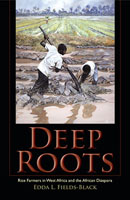
Edda L. Fields-Black. "Deep Roots:" Rice Farmers in West Africa and the African Diaspora. Bloomingdale and Indianapolis: Indiana University Press, 2008, 296 pp., $34.95 (cloth) ISBN 978-0-253-35219-4.
Reviewed for the African Diaspora Archaeology Newsletter by Andrew Agha, Brockington Associates, Inc., Mt. Pleasant, SC.
In 1794, a slave trader named Samuel Gamble detailed Baga rice growing techniques along the Rio Nunez River that he witnessed. An image he recorded of their fields is known mostly as being the cover of Daniel Littlefield's pivotal book, Rice and Slaves (1981). Deep Roots, the new work by Edda L. Fields-Black, expands on this historical account a thousand fold, as her dissertation fieldwork, in support of this book, was conducted on the same river Gamble wrote about. In doing so, Fields-Black portrays one of the most detailed ethnographic studies of rice growing today in West Africa, and attempts to apply what she learned through the language involved with rice agriculture to the Americas. She takes Littlefield's thesis, that Carolina planters wanted Windward Coast slaves because they knew how to grow rice, and expands on it by studying a specific group of West Africans and their historical development as rice growers. Her main data set is language -- root words and roots of words specifically -- and through Historical Linguistics, she is able to show how involved the history of rice growing in West Africa was.
Although at first glance the reader may think that her research has uncovered the "missing link" of how rice and the knowledge of it passed from Africa to Carolina, instead what Deep Roots is about is how rice growing started, and later evolved, for one river system on the coast of Guinea-Bissau. The central theme of the study are the processes of 'Inheritance and Innovation,' where people and cultures inherit ideas, traits, and technology from others that came after them, and how they then use innovation to create new, hybridized forms out of the old. Fields-Black references Judith Carney a great deal, and by doing so, opens up her readers to a seemingly similar study. However, rather than being a straight forward historical study of West Africa and its rice agriculture, it is instead an in depth study of historical linguistics, where the data discussed are the words and word origins for rice and everything related. In the end, Fields-Black portrays in great detail one microcosm of the diverse and varied landscape of Old World rice agriculture in West Africa, but does not show exactly how those techniques crossed the Atlantic to be adapted to New World plantation practices. Instead, the reader must take the West African techniques and decide if they were employed in the New World.
The introduction to this book recounts historical information and facts that some scholars and researchers familiar with rice studies will find refreshing, and possibly new, when seen in context with the new research outlined in this book. The reader must pay close attention to her description of the methods involved in her linguistics studies, and what it means to the study of rice, as a fair amount of readers of this book may not be inclined in the field of linguistics.
In Chapter 1, Fields-Black describes in great detail the ecology of the Rio Nunez and the agricultural place it holds in West Africa. She details how 'origins of rice' studies relate to this region, as well as what peoples from the interior regions have to do with this coastal setting. Being an avid researcher of rice agriculture myself, her photos and descriptions of rice growing techniques are some of the best examples of the technology I have ever seen in any publication. She outlines the fact that the Rio Nunez region has grown rice for many centuries, but how they came to grow rice is outlined in Chapter 2.
Her basis for Chapter 2 is determining whether or not rice came to the coast from the interior, if it appeared on its own, and how rice was grown as a strategy against famine. Here, her work in root words comes into play, as she attempts to find out what words originated on the coast versus those from the interior. This is important when showing how a complicated crop like rice was adapted to different mangrove swamps, what kinds of tools were needed, and how the technology began and then advanced once new people with new things, ideas, and words, migrated to the coast.
Chapter 3 is a focus on the interior people, how they worked their mangroves, what their survival skills were, and how they influenced the Rio Nunez region. Like Chapter 2, this chapter is very involved with historical linguistics, and the origins and changes of rice-related words. She is able to prove that words specific to cattle grazing, iron technology, and ecological farming practices are a result of interior people moving to better places along the coast. Fields-Black shows that rice was the end result of these migrations of words, ideas, technology, and people.
The book is an excellent example of the use of historical linguistics studies to develop insights into a non-linguistic topic, revealing, in this case, the complexity of rice cultivation. Chapter 4 shows the author's true strengths as a historical linguist, as she discusses how the creation of States and social centers in West Africa played major influences on rice development. The Rio Nunez was not an urban center like its counterparts in the interior, so the story of how it grew rice is an interesting one. She is critical of archaeologists throughout the book, but mostly in this chapter, citing their ignorance of non-urban sites and the need to know more about them as being pivotal to fully understanding societies like that at the Rio Nunez. She references the collaborative efforts of settled people and migrants to create innovative terminology for cultivating rice -- terminology that went hand in hand with technology.
Chapter 5 is the culmination of her West African language study, where Fields-Black is able to show that rice did evolve independently on the coast as a cooperation of different people from different places, and not primarily from foreign introducers of technology and ecological strategies. Again, the work she has done on root words across ethnic groups, and on who taught what to whom, is excellent. Although her work on defining who grew rice in the Rio Nunez region is thorough, her link between all of this technology in West Africa to South Carolina and Georgia is not as complete. Chapter 6 attempts to define that link.
In Chapter 6, Fields-Black discusses the role that ships and captains played in the transfer of rice knowledge and technology -- a group of people that rice historians and anthropologists have yet to divulge into for new directions in rice research. She explains that the captains procured enormous amounts of rice for their holds to feed their crew, and, their cargo of captives. This process was way more complicated than is usually discussed, and along with defining it well, she also points out how the process affected West Africa, which negatively altered their rice economy and changed it forever. Recent historians have argued against the prevalence of West African rice knowledge in Carolina in the early, formative years, which goes against Judith Carney's ideas on the origins of rice in the colony. These historians have shown the bold claims to be problematic through their use of the Trans-Atlantic Slave Trade database. With newly refined numbers from the database, she is able to show that the majority of slaves entering the ports in Charleston, and later Savannah, came from rice growing West Africa. Although this data, she points out, does not include the ships that went unregistered, and does not take into account that slaves at ports might have never grown rice themselves, the data does help to reinforce the idea that slaves from West Africa knew how to grow rice, and that their influence in numbers here coincided with the boom of rice as a commercial, industrial enterprise in the later half of the eighteenth century.
The Conclusions summarize the major points of the book by dealing with the important concepts that to scholars versed in Historical Linguistics may seem to be rudimentary, but to others, not so clear. The main thesis of the book -- Inheritance and Innovation -- is found here, and she does a good job defining the main thread of her argument. She was able to show that the inheritance of words, traits, skills, and technology by the people of the Rio Nunez and their neighbors gave way to innovation, where the words themselves show how traits changed, skills were improved upon, and technologies advanced. These concepts are laid out well in the Conclusions, but not anywhere else in the book. Instead, the beginning of the book reads like it will be a new historical study, but then quickly changes into a study of language that may not be so clear for the avid reader and student of rice culture and cultivation.
Being a historical archaeologist in South Carolina, who has researched and conducted fieldwork on Inland Rice plantations in and around the Charleston area for the last 12 years, I have to take very seriously any new work that deals with Africans and the transfer of rice technology. This book appeared to hold an answer to long sought after questions, or have ethnographic data that could potentially help us understand the Colonial-era fields in the Lowcountry. Fields-Black only touches on South Carolina and Georgia lightly, perhaps waiting to explain the linkages between the Windward Coast and the Lowcountry in her next book, which focuses on American rice culture more directly. However, although light on Lowcountry-African connections, her analysis of the Rio Nunez region of West Africa makes her possibly one of the best rice historians of that continent. She details methods and techniques that may have been used here in South Carolina or Georgia, and although we have no clear evidence of these skills, we can take the ethnographic data she has presented and try to apply it to our problems with the lack of documentation for the 1690-1760 period. If you want to learn a lot about how rice was and still is grown in a small region of West Africa, this book is an excellent choice.
[Return to table of contents]Book Review
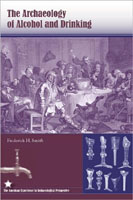
Frederick H. Smith The Archaeology of Alcohol and Drinking. Gainesville, FL: University Press of Florida, 2008, 208 pps., $24.95 (paper), ISBN 13: 978-0-8130-3290-0.
Reviewed for the African Diaspora Archaeology Newsletter by Aaron Brummitt, Tennessee Valley Authority, Lawton, OK.
This book is a continuation of Frederick H. Smith's earlier research (Caribbean Rum: A Social and Economic History 2005). In The Archaeology of Alcohol and Drinking, Frederick Smith synthesizes a wide body of research from the fields of cultural anthropology and social history in order to develop a framework that allows a better understanding of archaeological remains associated with alcohol. By developing a political-economic model similar to that utilized by Sidney Mintz in Sweetness and Power: The Place of Sugar in Modern History (1985) Smith is able to explain the diverse social, political, and economic behaviors related to drinking alcohol. This analytical system goes far beyond reinterpreting alcohol related material culture as simply another variable informing archaeologists of "foodways." Instead Smith's paradigm presents a set of unique social phenomena that are better interpreted with respect to world-wide economic and political systems.
The major themes that Smith individually addresses are the social functions and the material remains associated with the production, trade, and consumption of alcohol. Each chapter, which corresponds directly with one of these themes, explains a different aspect of the archaeological record and illuminates the social and economic reasons for the use and deposition of a variety of alcohol related artifact types.
In the introductory chapter, Smith explains both why historical archaeologists have avoided alcohol as a subject of study as well as the previous hindrance of this type of study caused by the temperance movement and its vestigial baggage. While not hiding the many harmful social and physical effects of alcohol, Smith advocates an objective critique of the role alcohol production, trade, and consumption played in past societies in order to properly assess the conscious choices made by individuals in the past. This critique aids in addressing the construction of identities associated with both secular and sacred uses of alcohol as well as total abstinence.
In Chapter 2, Smith provides a review of the material remains deposited through alcohol related cultural behaviors. By exploring a wide range of site types, Smith informs the reader of how analysis of alcohol specific artifacts such as glass and ceramic sherds, ethnobotanical remains, and a variety of distillation related metal objects can inform researchers about diachronic changes in production, trade, and consumption of alcoholic beverages.
Chapter 3 is a synthesis of previous archaeological research associated with the production of alcohol. In this chapter, Smith reviews a variety of studies ranging from pre-Incan beer production in Peru to late historic commercial distilleries in the former British colonies. The underlying thesis of this chapter is that colonial European expansion fostered a re-creation of European drinking patterns and simultaneously, through the impact to indigenous populations, transformed native drinking patterns. Smith closes the chapter by stating that historical archaeologists must question the economic and political forces that transformed the alcohol industry in order to make informed conclusions about the rise of world-wide trade patterns in the modern world.
Collectively, Chapters 4 and 5 address issues of social identity and interaction. By examining both the world-wide trade and associated social behavior of alcohol consumption these chapters reveal the nature of interaction between the producers, traders, and consumers of alcohol in the colonial world. Included in Chapter 5 is Smith's review of how South's artifact patterning (in Method and Theory in Historical Archaeology 1977) subsumes alcohol consumption into the "Kitchen Group" category, thereby obscuring the interpretive value of function based artifact enumerations. While South was well aware of this discrepancy, and used it to isolate soldier's alcohol-related behaviors at Fort Moultrie, most practitioners blindly categorize their recovered materials and, sadly, do very little to address the variability in behaviors beyond separating and tabulating the recovered materials.
The case study presented in Chapter 6 will be of particular interest to the readers of this publication and other African Diaspora Scholars. The case study is an examination of the archaeological remains that provide evidence of alcohol use in the Mapps Cave site in Barbados. Smith interprets the remains with respect to the 1816 slave uprising, the largest single revolt in Barbadian history. Smith's thesis is that Mapps Cave served as a refuge where the enslaved people at Mapps, Bayley's and other nearby sugar plantations could congregate.
Smith proposes that at Mapps Cave served as a sanctuary where the enslaved laborers could find relief from the strict social control and panoptic gaze of the planters. The consumption of alcohol allowed for a temporary respite and breakdown of otherwise rigid social barriers, and helped ease sociability between individuals. The conditional release from social pressures fostered by drinking alcohol likely facilitated the revolutionary planning and organization in Mapps Cave that culminated in the 1816 uprising.
As mentioned above, I found the explanatory power of Smith's framework most informative. Open-minded work, like that presented in this volume, will increase researcher's interpretive power and help scholars draw factual conclusions about past events. In addition to offering a synthesis of alcohol studies, and an intriguing case study, this volume also provides a more informed and nuanced view of artifact analysis than that offered by purely positivist thinkers. Possibly an update to both Hume's stodgy antiquarianism and Deetz's cold processualism, Smith's study incorporates human agency, action, and belief into the study of archaeologically recovered material. Rather than simply relying on documented trends, Smith attempts to explain how historical events transpired and offers an explanation that considers not only economic availability and social order, but also human choice and individual action.
This is a clearly written book. The book is targeted to an audience already familiar with the historic archaeology of the Caribbean, and a reader not particularly familiar with the subject would find much of the content clarified by more extensive discussions. The thirty figures included with the text aid the reader by clarifying the artifact and excavation descriptions. I did not notice any typographical or layout errors and the References Cited and Index sections are complete. This book would be a great addition to the library of anyone interested in colonial period archaeology, transatlantic trade, or the correlation of history with archaeologically derived data. Using history to inform interpretations of the archaeological record, Smith goes far to incorporate social history into archaeological research.
[Return to table of contents]Book Review
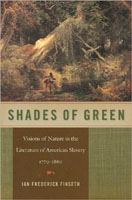
Ian Frederick Finseth, Shades of Green: Visions of Nature in the Literature of American Slavery, 1770-1860. Athens, GA: University of Georgia Press, 2009, 348 + xi pps., $39.95 cloth, ISBN 13 978-0-8203-2865-2.
Reviewed for the African Diaspora Archaeology Newsletter by Simon Lewis, College of Charleston, Department of English
Anglo-Nigerian writer Buchi Emecheta opens her 1983 novel The Rape of Shavi with the crash of a "bird of fire" into the desert landscape of Shavi, an imaginary African country somewhere on the fringes of the Sahara. The "bird of fire" is in fact a strange home-made aircraft called the Newark carrying its European passengers away from what they presume is imminent nuclear war. As the pale survivors struggle from the wreckage, the Shavians deliberate over how to treat these extraordinary creatures; everything hinges on whether they are properly "human:" if they are, the traditional Shavian hospitality demands that they be taken in and cared for; if not, they can be killed. Luckily for the Newarkers (but unluckily for the Shavians), the signs of mourning for a dead child, convince the Shavians that the strangers really are human, so they take them in. Emecheta's novel thus opens with a deliberate repetition-with-a-twist of eighteenth-century European and Euro-American definitional debates over race and human nature where an apparently philosophical judgment masks a life-or-death political decision. In this single and singular humanus ex machine plot-device Emecheta dramatizes the crucial way in which epistemology, ideology and power co-exist in the contemporary post-nuclear world. What Emecheta is responding to in this dramatic fiction, of course, is the actual world-historical consequences of European and Euro-American racial ideology, especially in the United States, that is the subject of Ian Finseth's fine new book Shades of Green: Visions of Nature in the Literature of American Slavery, 1770-1860.
Although an English professor by disciplinary training, Finseth is as concerned with intellectual history, in all its facets as much as he is with literary analysis. In Shades of Green he has produced a rich, dense, wide-ranging study of the ways in which antebellum American writers' and artists' representations of nature and the landscape informed and were informed by their ideas of culture. Paying particular attention to the vexed relationship between the "human" and the "natural," Finseth offers compelling readings of the work of writers from the eighteenth-century abolitionists Olaudah Equiano and Anthony Benezet, through to Frederick Douglass and Harriet Beecher Stowe to support his claim that "natural science informed antislavery rhetoric and philosophy more fully than we have recognized" (p. 5). The claim is an important one according to Finseth, in that nature played a "central yet protean role in the representational war over racial slavery, and therefore over American national identity" (p. 1). What's more, as Finseth himself emphasizes in a brief but significant "Epilogue," his arguments resonate long after the antebellum period and contribute to the ongoing ethical and social debates that are at the root not just of disciplinary subgenres such as ecocriticism, but also of public issues such as stem-cell research, environmental policy, and biotechnology generally. And, as my reference to The Rape of Shavi indicates, the geographical reach of their significance extends well beyond the borders of the United States.
The book opens with a tightly argued introduction that sets out the rhetorical tensions between an abolitionist rhetoric that variously contained both universalizing and racializing notions of the human, and that variously embraced ideas of nature as idealized "manifestation of moral and emotional harmony" (p. 6) and in need of taming and improvement. Chapter One "Nature and Antislavery Philosophy" continues to set out the intellectual field fairly broadly, covering a range of authors from James Ramsay to Benjamin Banneker, and introducing discussion of the two chief literary modes associated with writing about nature -- the pastoral and the georgic -- in a period in the history of Western thought when Romanticism fostered an anxiety "that an empirical, analytical approach to nature would destroy the feelings of mystery, wonder, and even reverence that the natural world could inspire" (p. 65).
Following these two wide-ranging chapters, the bulk of the book is mainly given over to comparative readings of astutely paired authors, white and black. These pairings are strikingly original in conception and lead to some fascinating insights. Analysis of the two "expatriates and cultural hybrids" Crèvecoeur and Equiano, for instance, draws Finseth to comment on the uses and limits of narrative in opposing slavery and the slave-trade as a violation of natural order.
Likewise, in "Nations of Blood" (Chapter Four), Finseth reads Emerson's developing attitudes to race against David Walker's and Martin Delany's proto-black nationalism. Finseth argues that each author's search for "some form of social utopia [. . . ] authorized, as always, by natural law" (p. 164) contains its own internal contradictions. Of Delany's Blake, Finseth writes that the novel "expresses a tension between human unity and racial division, a simultaneous assertion of a common human nature, eternally unchanging, which entitles all people to natural rights, and of the existence of multiple racial bloods" (p. 184). Finseth is particularly sharp in discussing Emerson's later attitudes to race and nature suggesting that Emerson's favoring of a "biological intermixture as the principal dynamic of American progress" may work "ultimately to consign nonwhites to a mere supporting role in the drama of Anglo-American progress" (p. 204).
Similar issues that probe what Finseth calls the "continuing dilemma of American liberal thought: its fundamental commitment to the intrinsic worth of the individual, and yet its conflicting impulses toward identitarian racialism on one side and inclusive humanism on the other" (p. 206) animate Chapter Six "Revisiting, Reliving, Reforming." In this chapter, Finseth makes a persuasive case for re-reading the later work of Harriet Beecher Stowe and Frederick Douglass not just against each other to draw attention to their racial positioning, but against each author's own earlier, canonical work. In urging us to read Stowe's 1856 novel Dred: A Tale of the Great Dismal Swamp as an intellectual advance on the sentimentalism of Uncle Tom's Cabin, Finseth argues that Stowe "imagines a principle of creative destructiveness in the natural world that works to philosophically authorize slave rebellion and violence" (p. 252). Although he sees Stowe as still trafficking in racial essentialism to a degree, Finseth insists that Dred's representation of nature generally demonstrates a clear consciousness that the idealizing tendencies of pastoral exist in a perpetual give-and-take with other discourses and realities" (p. 265) that perpetually threaten it with their "disruptive, entropic forces" (p. 267). In My Bondage and My Freedom, Finseth sees Douglass producing a more all-encompassing moral condemnation of American (as opposed to specifically Southern) slavery in which "Douglass means to connect not only the southern fields with the blood of his enslaved people, but the systematic violation of African Americans with the systemic pollution of the natural world" (p. 281).
In between the Delany/Emerson and Stowe/Douglass chapters, Chapter Five, "Race in the Landscape," extends the range of Finseth's analysis by offering some readings of antebellum American painting. Finseth draws attention to the way in which American painters confronted the problem of how to represent black labor in the dignified fashion that eclogue or pastoral traditions had established, when representations of black idleness might reinforce negative stereotypes. Another of Finseth's valuable insights in this chapter, that American artists of this period appeared unable to imagine anything but a "lone black figure, cut off from family and community" (p. 239), perhaps draws attention to Finseth's limiting himself to professional artists (whether formally trained or self-taught) who, whatever their degree of originality, operated essentially within the realms of convention both of production and of consumption and circulation. Consideration of vernacular forms, and the inclusion of native American representations of nature and race might have allowed Finseth to expand his cultural analysis still further and move beyond an implicitly bi-racializing vision of American identity.
[Return to table of contents]Book Review
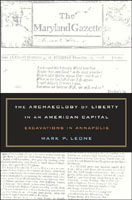
H-NET BOOK REVIEW
Published by H-Urban, http://www.h-net.org/~urban/ (May 2009).
Mark P. Leone. The Archaeology of Liberty in an American Capital: Excavations in Annapolis. Berkeley: University of California Press, 2005. xxvi + 327 pp. $41.95 (cloth), ISBN 978-0-520-24450-4.
Reviewed for H-Urban by Charles Orser, Research and Collections, New York State Museum.
Archaeology and the Intangible in American History
People who wonder what historical archaeologists actually do, and more importantly what they can teach us that we cannot learn from written documents, will be surprised and hopefully delighted with this book. Here, readers will discover the true reality of archaeological research: that it is seldom the stuff of the movies and that interpretations are indeed hard won and never obvious. Readers will get insights into the true nature and promise of historical archaeology, the ways in which various meanings can be imparted to the past, and the role that archaeology plays in interrogating what we think we already know.
Leone's program, called Archaeology in Annapolis, is one of the oldest and most successful archaeological programs in the world. This book is based on twenty-two years of excavations and analyses of home sites and public buildings ranging from the grand houses and manicured landscapes of the elite to the simple homes of men and women held in lifelong bondage. Often using an extremely personal perspective, Leone explores the meanings of pieces of material culture, extending from the terribly common -- the toothbrush -- to the more unusual -- pieces of printer's type. But this is not a mundane recital of archaeological minutiae. Instead, Leone unravels the complex history of Annapolis by examining the notion of liberty through the lens of such objects.
Liberty would not immediately occur to most people as a fitting topic for archaeological research. After all, what does liberty actually look like and how do we know it when we see it? Beginning with the ideology of individualism that was and still is the stuff of the American Dream, Leone traverses an archaeological landscape replete with signs that real men and women living every day in Annapolis struggled to create their own sense of liberty. Nowhere is this search for freedom more apparent, says Leone, than among Annapolis's African American community.
Leone uses ideas from Jürgen Habermas and Louis Althusser to investigate the historical culture of African America as it was expressed in Annapolis. One of his most interesting analyses focuses on the discovery and meaning of spirit bundles. Spirit bundles appear as caches of artifacts found together in the soil: buttons, pins, broken plates, and other objects that African Americans used both to protect themselves from evil forces and to distinguish themselves from their owners. Rather than perceiving these bundles as simple proof of the retention of African customs in America -- a common conclusion of historical archaeologists in past years -- Leone situates the bundles firmly within the struggle for liberty.
Ultimately, Leone's analysis focuses on the ways in which men and women in capitalist societies wrestle with the realities of that economic system. As he notes, "The promise of and quest for freedom masked the inescapable reality of capitalism's base and essence" (p. 247). As people become absorbed in the system, they find various ways to accept it or to struggle against it, and it is this ongoing conflict that Leone addresses so adroitly in this book.
This book is not what people unfamiliar with historical archaeology might expect; it is much more than that. Rather than offer detailed descriptions of artifacts supplemented with copious pictures and drawings, as one might expect in an archaeology book based on excavation, Leone takes us far beyond this surface world into the mind of the archaeologist attempting to untangle the meanings of what he sees in the evidence. We accompany him as he searches for answers, as he strives to negotiate the complex past he has entered. The clues are diverse and lead in different directions, and some are misleading. But through it all, Leone comes to understand better the notion of liberty as it was struggled for and expressed in Annapolis, Maryland, and the ways in which historical archaeologists can use the remaining evidence -- memories, histories, colonial newspapers, toothbrushes, dishes, and landscapes -- to educate us about the world in which we live.
Copyright (c) 2009 by H-Net, all rights reserved. H-Net permits the redistribution and reprinting of this work for nonprofit, educational purposes.[Return to table of contents]
Book Review
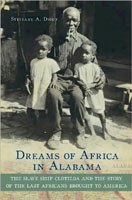
H-NET BOOK REVIEW
Published by H-Africa, http://www.h-net.org/~africa/ (April 2009).
Sylviane A. Diouf. Dreams of Africa in Alabama: The Story of the Clotilda and the Last Enslaved Africans Brought to America. Oxford Oxford University Press, 2007. 416 pp., $30.00 (cloth), ISBN 978-0-19-531104-4.
Reviewed for H-Africa by Nana Yaw B. Sapong, Department of History, Southern Illinois University-Carbondale.
ADAN Editor's Note: This book was awarded the 2007 Wesley-Logan Prize of the American Historical Association.
All Good Men and Women Try to Forget: They Have Forgotten!
In the summer of 2007, I paid a visit to an old haunt of mine: Ghana's Cape Coast castle. Standing on a battlement with neatly arranged canons and cannonballs, the waves came crashing incessantly and showered me with fine spray. In addition to the sound of seagulls, the waves carried other voices to me: the soul-wrenching melancholic cries of fear, despair, and uncertainty. The Cape Coast castle was a major European fortress that held slaves before their departure to the New World. Readers will hear these voices as they read Sylviane A. Diouf's Dreams of Africa in Alabama. This book is a fine addition to existing narratives of the saga of the transatlantic slave trade and its effects on people and cultures on both sides of the Atlantic. It is a reconstruction of the lives of the last documented group of enslaved Africans shipped to the United States, their courage and resilience, and their hopes of returning to their ancestral homes one day. To them, the New World was just a transient experience.
Dreams of Africa in Alabama has a dual purpose: to draw attention to a historical inaccuracy and to emphasize the primacy of Old World cultures in explaining the nature of societies in the New World. To Diouf, studies in the transatlantic slave trade have either dismissed as a hoax or ignored the arrival of the slave ship Clotilda and its enslaved passengers to the United States in the summer of 1860. Instead, the Wanderer has been touted by historians and writers as the last slave ship to the United States, although the Wanderer's arrival antedates the arrival of the Clotilda. On the grander scale of historical interpretation, Diouf points out the unique experience of the survivors of the Clotilda as a case study of Old World cultural persistence and of resistance to New World acculturation. By drawing on their cultural experiences in Africa, Cudjo Lewis -- the leader of the nascent community -- and his shipmates on the Clotilda built a close-knit African community that survived the Civil War, Reconstruction, World War I, and the Great Depression. The shipmates of the Clotilda "viewed and called themselves Africans and willfully maintained this identity with all the attendant manners, languages, behaviors, and practices that sustained it" (p. 232). They were Africans because they went through the cycles of life (birth, naming, puberty, marriage, and death) as if they were still in Africa.
The book builds its themes in a logical and sequential manner. Diouf uses the first two chapters to lay out the historical context of her narrative, analysis, and interpretation. The reader is thus given a summary of the political economy of plantocracy in the United States and West Africa during the period of enforcement of the abolition of the transatlantic slave trade. In the United States, various attempts were made by southern states to revive the international trade in slaves because it was costly to acquire labor through the domestic trade. The southern press was rife with propaganda about the civilizing and Christianizing mission, and putting the worthless Africans to work. Across the Atlantic on the coast of West Africa, the era of "legitimate" commerce was in full swing, and so was the domestic slave trade. Diouf writes of marauding communities and martial kingdoms whose preoccupation was enslaving fellow Africans for sale, not only to West African palm oil plantations but also to the Americas. Diouf then moves on to the nitty-gritty of slave acquisition in West Africa, the exchange of hands, and preparations for the Middle Passage. The third chapter eases the reader into the Middle Passage while chapters 4, 5, and 6 deal with the realities of life in the southern United States as a slave through the period of the Civil War and emancipation. After emancipation, chapter 7 narrates how the shipmates of the Clotilda decided to found Africa Town and become citizens of the United States after "valiant attempts at leaving" proved futile (p. 171). Chapters 8 and 9 explore the social issues arising from building this new community, such as racism, segregation, crime and violence, black disenfranchisement, and legal battles for compensation. The last two chapters detail the particularly devastating events surrounding Lewis who got hit by a train; had a protracted legal battle with Louisville & Nashville Railroad Company; and lost his children and Abile, his wife and companion. The book concludes with contemporary attempts at reviving and keeping the African roots of Africa Town alive. These include trying to establish relations with Benin.
Diouf is at pains to consult a vast array of sources, including government documents, newspaper prints, oral histories, missionary accounts, ship documents, and linguistic data to put her themes across. In assigning agency to African cultural experiences, Diouf takes great care to explain African cultural markers, such as group affiliation, naming and its significance, and the institutions of marriage and religion, among others. Throughout the chapters, Diouf goes to lengths to point out the African origins of life and events in Africa Town. She pays particular attention to the names and origin of the enslaved shipmates of the Clotilda, asserting that their names were a crucial part of their African identity. When Lewis's son died, he conjured his son's African personality by calling him by his Yoruba name, Feichitan. Indeed, "in the midst of misery, Africa was the refuge" (p. 214). Again, the surviving shipmates of the Clotilda asked that their original names be used in their biographies because of "their attachment to their peoples and their homes, and of their unwavering identity as small-town West Africans" (p. 220). What I find more profound is how Diouf explains that to the enslaved Africans, the Middle Passage was tragic not because of the dreadful experiences that captives had to endure but because of the racial nature that slavery assumed, and their failure to grasp it. To the enslaved Africans on the Clotilda, "they were free men held against their will," not slaves. "The abject degradation ... and the vile bashing of their honor did not seem to have altered their sense of identity as freeborn men and women who found themselves prisoners" (p. 70).
Diouf also explores issues around ideas of and requests for compensation after emancipation. To the Africans, the thought of community went hand in glove with the acquisition of land. They therefore decided to ask for land from their ex-masters: in the case of the survivors of the Clotilda, the Meahers, the family that acquired them. According to Diouf, the Africans "had based their claim on two grounds: compensation was due not only because of the free labor they had provided when enslaved, but also because they had been uprooted from family and land" (pp. 152-153). In a comparative study of the claims of slaves and ex-slaves to family and property in southern Gold Coast and the southern states of the United States in the nineteenth century, Dylan Penningroth sheds more light on the idea of compensation. Penningroth asserts that the "histories of both regions were shaped by debates about the claims that slaves and their descendants made to kinship and to the products of their labor."[1] Thus, when the shipmates elected Lewis to speak to Timothy Meaher about compensation in land, they thought they had a moral right to their claims. Meaher did not see it that way, claiming that he treated his slaves well compared to other plantations in the area, somehow voiding any such claims.
Dreams of Africa in Alabama is an excellent attempt to explain the founding of a New World society via Old World cultural inheritance. Diouf's model of interpretation is in contrast to other scholars who argue for the primacy of the New World environment in determining social formations. However, there are some fluid situations that make such wholesale models of interpretation problematic. The Old World had its cultural baggage and the New World had its realities and challenges, forcing continuity, adaptation, and sometimes changes. David Eltis, Philip Morgan, and David Richardson argue that Atlantic history needs to "break out of" this "straitjacket" imposition because "community and cultural formation in the early Americas was a product of many forces."[2] Dreams of Africa in Alabama has instances of adaptation -- such as slaves taking on American names -- though Diouf does not present these as markers of acculturation but rather as survival strategies. In their "inner African circle," they still kept their African names. My own sense is that the first and second generations of Clotilda shipmates were able to resist acculturation because of the extant memories of Africa. However, by the fourth generation, dreams of Africa were fading, and they died with Lewis in 1935.
Diouf's book is a welcome addition to texts on Atlantic history as well as African American history. University instructors may find it appropriate as an assigned text in an undergraduate seminar or graduate colloquium on Atlantic history. The heartrending empathy aroused by Diouf's book is echoed in Ama Ata Aidoo's Anowa (1980). In Anowa, Anowa's grandma (Nana) tells Anowa of her adventures to the sea that was bigger than any river and the forts on the coast that rose up to the sky and contained many rooms. These "big houses" were built by the "pale men" for keeping slaves. Asked what a slave is, Nana replies that a slave is "one who is bought and sold," and that the "pale men" got the slaves from the land. Then Anowa asks Nana, "'What happened to those who were taken away? Do people hear from them? How are they?' Nana told Anowa to shut up and that it was time to go to bed: 'No one talks of these things anymore! All good men and women try to forget; they have forgotten!'"[3] For Lewis and the others from the Clotilda, they never forgot. Bonded together by slavery, this group attempted to repatriate to Africa after emancipation. When the possibility of repatriation became bleak, they decided to "recreate Africa where they were. They shared all they had, saved money, built each other's houses, and solved problems collectively" (p. 3). They held on to the dream of reuniting with their ancestral land by replicating Africa in Alabama.
Notes[1]. Dylan Penningroth, "The Claims of Slaves and Ex-Slaves to Family and Property: A Transatlantic Comparison." American Historical Review 112, no. 4 (October 2007): 1040.
[2]. David Eltis, Philip Morgan, and David Richardson, "Agency and Diaspora in Atlantic History: Reassessing the African Contribution to Rice Cultivation in the Americas." American Historical Review 112, no. 5 (December 2007): 1332.
[3]. Ama Ata Aidoo, Anowa (Harlow and Essex: Longman Drumbeat, 1980), 44-46.
Copyright (c) 2009 by H-Net, all rights reserved. H-Net permits the redistribution and reprinting of this work for nonprofit, educational purposes.
[Return to table of contents]

